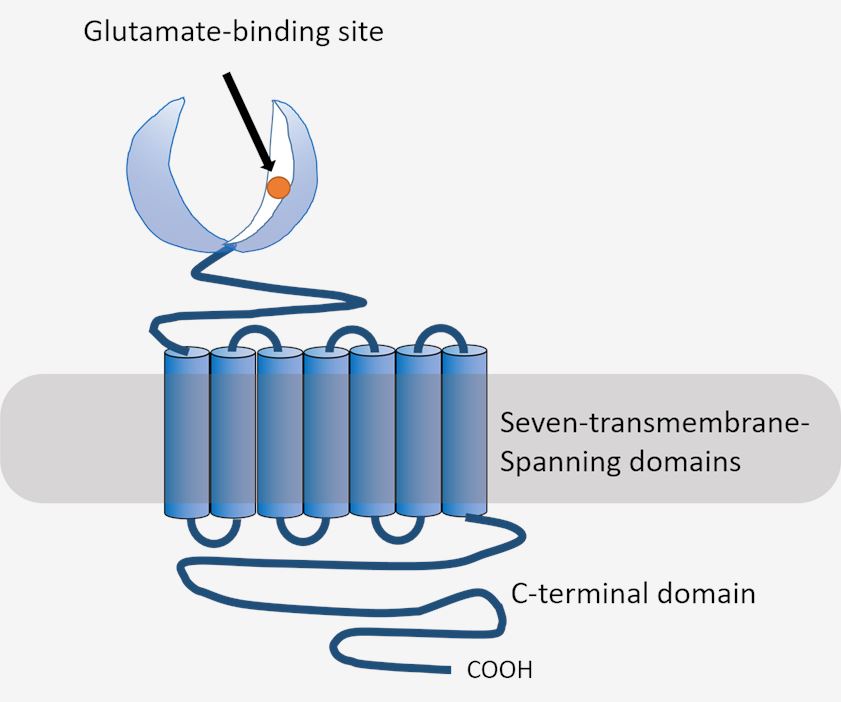Introduction of GRM3
GRM3 (mGluR3) belongs to group II receptors of metabotropic glutamate receptors (mGluRs), which are coupled to Gi/o. mGluRs are members of the family C G-protein coupled receptors (GPCRs) and play central roles in neuronal excitation in the central nervous system. Like GRM2, GRM3 modulates neuronal excitability by regulating glutamate (and GABA) release from presynaptic terminals, and postsynaptically by regulating the activity of adenylate cyclase and various ion channels. Structurally, GRM3 has a large extracellular domain, which is a main characteristic of the family C GPCRs and is capable of binding glutamate, transmitting signals through the receptor protein to intracellular signaling partners. GRM3 is widely expressed in neurons and glia with high expression in the cerebral cortex, hippocampus, thalamus, striatum andsubstantianigra.
| Basic Information of GRM3 | |
| Protein Name | Metabotropic glutamate receptor 3 |
| Gene Name | GRM3 |
| Organism | Homo sapiens (Human) |
| UniProt ID | Q14832 |
| Transmembrane Times | 7 |
| Length (aa) | 879 |
| Sequence |
MKMLTRLQVLTLALFSKGFLLSLGDHNFLRREIKIEGDLVLGGLFPINEKGTGTEECGRI NEDRGIQRLEAMLFAIDEINKDDYLLPGVKLGVHILDTCSRDTYALEQSLEFVRASLTKV DEAEYMCPDGSYAIQENIPLLIAGVIGGSYSSVSIQVANLLRLFQIPQISYASTSAKLSD KSRYDYFARTVPPDFYQAKAMAEILRFFNWTYVSTVASEGDYGETGIEAFEQEARLRNIC IATAEKVGRSNIRKSYDSVIRELLQKPNARVVVLFMRSDDSRELIAAASRANASFTWVAS DGWGAQESIIKGSEHVAYGAITLELASQPVRQFDRYFQSLNPYNNHRNPWFRDFWEQKFQ CSLQNKRNHRRVCDKHLAIDSSNYEQESKIMFVVNAVYAMAHALHKMQRTLCPNTTKLCD AMKILDGKKLYKDYLLKINFTAPFNPNKDADSIVKFDTFGDGMGRYNVFNFQNVGGKYSY LKVGHWAETLSLDVNSIHWSRNSVPTSQCSDPCAPNEMKNMQPGDVCCWICIPCEPYEYL ADEFTCMDCGSGQWPTADLTGCYDLPEDYIRWEDAWAIGPVTIACLGFMCTCMVVTVFIK HNNTPLVKASGRELCYILLFGVGLSYCMTFFFIAKPSPVICALRRLGLGSSFAICYSALL TKTNCIARIFDGVKNGAQRPKFISPSSQVFICLGLILVQIVMVSVWLILEAPGTRRYTLA EKRETVILKCNVKDSSMLISLTYDVILVILCTVYAFKTRKCPENFNEAKFIGFTMYTTCI IWLAFLPIFYVTSSDYRVQTTTMCISVSLSGFVVLGCLFAPKVHIILFQPQKNVVTHRLH LNRFSVSGTGTTYSQSSASTYVPTVCNGREVLDSTTSSL |
Functions of GRM3 Membrane Protein
The functions of GRM3 mainly stem from knockout mice. Behavioral studies of mice lacking GRM3 suggested a role of this receptor in anxiety behaviors. Moreover, polymorphisms in the GRM3 encoding gene GRM3 have been linked to schizophrenia and cognitive performance in humans. Thus, the agonist, antagonist and allosteric modulator drugs of GRM3 can now be explored as new treatments for a variety of mental illness. LY354740 and LY379268 are two potent and highly selective agonists of group II mGluRs (mGluR2 and mGluR3), which are used to provide insight into the in vitro and in vivo functional studies of these receptors. Moreover, LY379268 has been found to attenuate extinction latencies and the reinstatement of morphine-induced conditioned place preference in rats.

Applications of GRM3 Membrane Protein in Literature
This article utilized novel mGluRsubtype-specific allosteric modulators and knockout mice to show that the mGluR3 was responsible for potentiating βAR-elicited cAMP responses in brain slices.
This article investigated the mechanisms of GCPII inhibitors in animal models of memory and memory loss. The data supported that inhibitors of GCPII were efficacious in object recognition models of normal memory and memory deficits via mGluR3 mediated process.
This study showed that the genetic deletion of mGluR3 caused significantly reduced spontaneous alternation and the application of MK-801enhanced locomotion more than wild type mice.
This finding indicated that the striatal expression of N-acetylaspartatesynthetaseShati/Nat8l played a role in major depressive disorder via the mGluR3-mediated functional control of the serotonergic neuronal system.
This article studies the tumor-associated variants of the mutated GRM3 gene and found that the oncogenic properties of GRM3 could be mediated, at least in part, by alterations in cAMP signaling.
GRM3 Preparation Options
Extracting membrane proteins from native lipid environment with structural and functional integrity is a critical step in biochemistry and structural biology studies. As a reliable research partner, Creative Biolabs is dedicated to providing tailored solutions according to your specific membrane protein preparation project requirements. Please see Magic™ Membrane Protein Production Service to learn more about our services. Aided by our versatile Magic™ anti-membrane protein antibody discovery platform, we also provide customized anti-GRM3 antibody development services.
Creative Biolabs provides individual consulting and develops a highly customized and flexible project strategy that is tailored to your needs. Moreover, we work side-by-side with our clients to ensure high quality and efficiency. Contact us for more details about our membrane protein preparation services.
All listed services and products are For Research Use Only. Do Not use in any diagnostic or therapeutic applications.